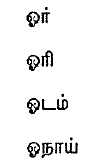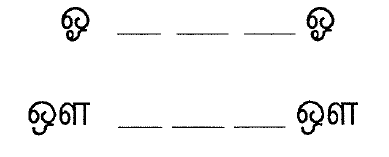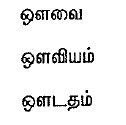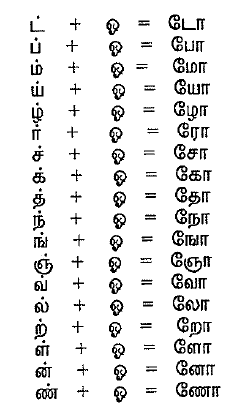Frame 15

The case of the long vowel, (oo) ![]() , the movements of the speech organs are about the same as those for its corresponding short vowel (o)
, the movements of the speech organs are about the same as those for its corresponding short vowel (o) ![]() except for the length of duration. This sound is described as the mid back, rounded long vowel. It occurs in all the positions in a word.
except for the length of duration. This sound is described as the mid back, rounded long vowel. It occurs in all the positions in a word.
The sound, (au) is combination of a and u. a is an open central vowel and u is rounded back vowel.
This sound is represented by the letter ![]() . This sound occurs in the word initial, medial, and final positions. This is considered as a long vowel. Like other vowels,
. This sound occurs in the word initial, medial, and final positions. This is considered as a long vowel. Like other vowels, ![]() is used as it is in the word initial position and elsewhere the presents of this vowel is represented by the secondary symbol.
is used as it is in the word initial position and elsewhere the presents of this vowel is represented by the secondary symbol.
Copy the letter three times (see Appendix I for hand-movements).

Read the following words.

Compare the letter ![]() with the letter for (au). (see Appendix I for hand-movements).
with the letter for (au). (see Appendix I for hand-movements).
Write the letters three times each. Your letters should be similar to the one given at the extreme right.

Read the words.

Secondary symbol for ![]() is
is ![]() (see Appendix I & II for hand-movements, also look at Chart III for old and modern Tamil use of secondary symbol) . Thus the secondary symbol for the vowel
(see Appendix I & II for hand-movements, also look at Chart III for old and modern Tamil use of secondary symbol) . Thus the secondary symbol for the vowel ![]() consists of two parts and the consonant letter is placed in middle. The secondary symbol for the vowel
consists of two parts and the consonant letter is placed in middle. The secondary symbol for the vowel ![]() (Frame 7) and the secondary symbol for the vowel
(Frame 7) and the secondary symbol for the vowel ![]() ‚ (Frame 4) together serve as secondary symbol for the vowel
‚ (Frame 4) together serve as secondary symbol for the vowel ![]() . The primary consonant letter is in between. Look at the vowel consonant combinations below.
. The primary consonant letter is in between. Look at the vowel consonant combinations below.
